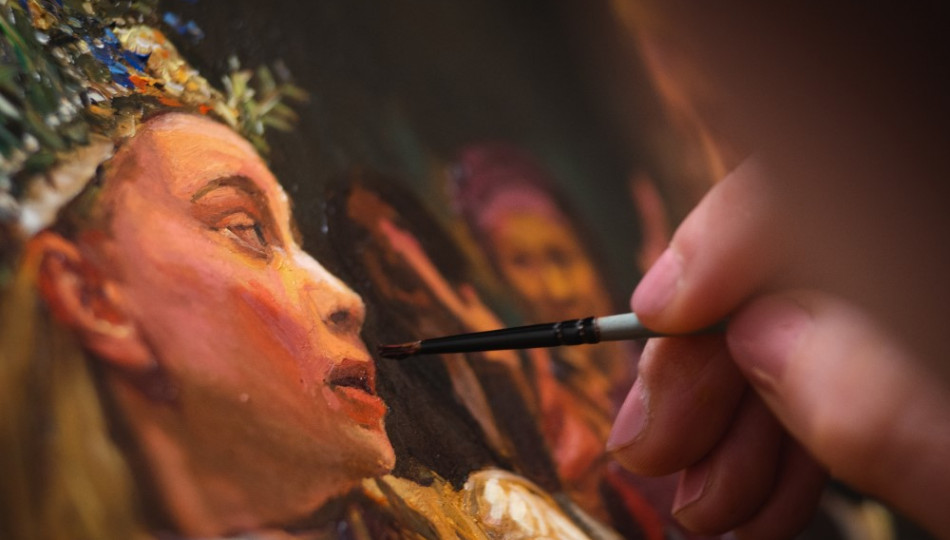“The Peasants” movie review – A woman trapped in society (and an oil painting)

Editor

materiały prasowe
related articles
related offers
The backstory
Five years ago filmmakers DK Welchman and Hugh Welchman earned an Oscar nomination and over 40 awards for their “Loving Vincent” – a movie revolving around the life and work of Vincent van Gogh. Its success set a high bar to clear, as well as the question: how on earth can they follow that up?
Another movie about a famous painter? “Ravishing Rembrandt?” “Perplexing Picasso?”
Such propositions, on top of drawing attention with titles suitable for the cover of a bodice-ripper, would offer a subject matter instantly recognizable to an average (if somewhat artistic and amorous) Joe and Jane.
Yet the dynamic-duo directors didn’t go for the obvious choice. They instead opted for the adaptation of a less titillating title, “The Peasants.” It was quite a bold decision, too. The book the movie is based on was written between 1904-1909, and yes, it did win Wladyslaw Reymont a Nobel Prize for Literature in 1924. But it has since fallen into relative obscurity. Nowadays the title “The Peasants” gets the most recognition from Polish high school students, forced to familiarize themselves with excerpts from the novel to pass their Matura exam and go to college.
Still, as much as high schoolers in Poland might be ecstatic to go to the cinema and skip out on the joy of reading a 1000-page novel about the reality of life in the poverty-stricken fictional 19th-century countryside, they make for a rather small ready-made audience.
The process
The financial risk of the venture is doubled when you think of the painted animation technique the filmmakers decided to apply. In practice, this means that shooting the movie on a traditional set with actors is just a first step. The next one – painting the images on canvas, frame by frame – is the most important and the most strenuous. This process required the effort of over 100 painters and 200,000 hours of work, which put differently, is 8333 days and 8 hours, amounting to almost 23 years of work! To put it in context: you could literally build a pyramid in this amount of time.
The result
Thankfully, upon watching the movie you will soon realize that it was worth every penny.
The painted vistas are breathtaking: sometimes in their idyllic calmness, sometimes with the power of an ongoing storm, as in the scene of Jagna’s and Antek's first romantic encounter.
The camerawork – is dynamic and masterful, and when accompanied by the amazing soundtrack by Łukasz L.U.C. Rostowski, who incorporated many Polish folk songs, seems to be able to do magic. This is most noticeable in the scene of Jagna’s wedding to Boryna, where the atmosphere slowly loses its joyfulness and warmth to transition into a frantic and discomforting experience. All this allows the viewers to resonate with the emotions of the characters and helps to underline the nuanced performance of the actors.
All in all, the usage of the painted animation technique makes it seem like the characters are trapped in an oil painting. It is beautiful to behold, but upon closer inspection, we soon learn that living in one is anything but that.
The story
While the source material might not be known to people outside of Poland, the main themes – of family bonds and family duty, of love and betrayal, of social norms and the harsh ways in which we can punish those who overstep them – are timeless and universal.
In the span of four books, each covering a different period of the year, we watch as together with seasons change the lives of smallfolk in Lipce, a 19th-century Polish village.
The main characters in the story:
Maciej Boryna
(Mirosław Baka) – an older man in his late fifties, twice married and twice widowed, is on the lookout for a third wife. Despite his age, he is still the most eligible bachelor in Lipce: healthy and equally wealthy, with a great amount of fields to plant crops on and a very well-kept, prosperous farm. This makes him the object of widespread envy, but also a significant figure in the community, a man to respect and whose will one should follow. The only people who refuse to do so are those related to Maciej, as they want him to retire and to rewrite ownership of all his best land to their families.
Boryna does not intend to recede from the foreground yet, for several reasons. First, he feels he is still quite capable of managing his property, thank you very much. Second – his prosperity is the source of his social standing and influence. Third and most important – losing the land might be equal to literally losing his life. This is what happened to Jagustynka – a character absent in the movie, but who was significant in the book – an older lady who had rewritten her holdings to her children, who then kicked her out of her own house the second the ink on the paper was dry.
For the reasons above, Boryna’s answer to his family’s plea to give them his land basically comes down to:
BORYNA: Eee, no, thank you, but I think I’ll pass. And you know, all my earthly possessions will pass to you as soon as I pass on. There will be a lot of passing going around.
Then, because Boryna still feels like, you know, living, he is persuaded to take a wife. Given that the wife he picks for himself is a young girl of nineteen (so technically still in her -teens) he might be also trying to teach his family a lesson. And its curriculum goes:
BORYNA: Yeah, I still got it! So… remember when I said I will give you all my lands upon my death? Well, define all, because I’ve just assigned all my finest fields to Jagna. Did I mention that she is nineteen?
Then I imagine, one of his many children would feel obligated to point out:
CHILD NUMBER X: But Father! That’s even younger than I am!
This in turn would prompt an answer like the one from the classic SNL episode with John Mulaney:
BORYNA: “Age is just a number the government keeps track of!“ and “You’re only as old as you feel. Do you know what statutory means? It means I looked it up and we’re on the right side of the cusp.”
Antek Boryna
(Robert Gulaczyk) is Maciej’s son, Jagna’s lover, a husband and a father. And he fails abominably in all of the above roles. To put it shortly: he cheats on the mother of his children with his father's wife. He resents his father for not rewriting the land to him, then resents his wife when she has the audacity to accept his father's help to feed their children after said father kicks Antek out as a result of a physical altercation.
Then, of course, he plans to kill his progenitor, but changes his mind in the last second, and ends up helping him. You could technically consider it to be a noble deed, but should you, though? He sure does take his sweet time to come to the decision to save his dear old da. Long enough that by the time he comes to the rescue, Maciej is already a dead man walking. The scene basically amounts to this:
ANTEK: Behold, Father! Tis I, Antek, yer backstabbing son! “Come with me if you want to live!” I maypah planned to shoot ye in the back, but frankly, every day I don’t kill ye – I save yer life.
BORYNA: (lying lifelessly on the frozen ground and choking on his own blood)
ANTEK: Have you no kind word to your rescuer, Father? Oh, this is so like you.
Jagna Boryna
(Kamila Urzędowska) is the aforementioned 19-year-old girl. She is a free-spirited, romantic, and artistic soul, and with her fair hair and eyes of blue she is considered to be exceptionally beautiful. All of those qualities could be regarded as positives, but for Jagna they turn out to be the bane of her life. She is ruled by sensibility, not sense, hence she acts recklessly and oft gives offence. To help her family prospects Jagna reluctantly agrees to marry Maciej Boryna, despite being romantically involved with his son, Antek, who himself is a married man.
Jagna's beauty allows her to easily entice men, but it’s a double-edged sword. The male attention she gets is often undesired and the other women in the community gradually start to perceive her comportment with men as a source of depravation. This is an unfair division of blame – after all, the men pining after her are responsible for their indiscretions at least to the same degree as Jagna. Yet in a way, this transference of blame is a common psychological defense mechanism – it is easier to look for external factors to blame than to face the fact that someone we love is the one who caused us pain.
Perhaps Jagna's biggest flaw flows from her inability to understand the role of social norms and, more pragmatically, wealth and property. She finds them of little importance and thus is blinded to lengths some people are willing to go to for money, as well as the outrage of society when moral standards are overstepped.
All in all, the punishment she receives has little to do with justice. The reckoning is an expertly crafted scene, where the filmmakers managed to convey that as much as the townfolk attempt to shame and humiliate Jagna, in doing so they shed their own humanity. This scene is vivid and realistic in its brutality, and it's harrowing to watch. Quite frankly, in comparison it makes Cersei Lannister’s walk of shame look like a walk in the park.
Thus, as Jagna was slowly rising from the ground in the last scene of the movie, I couldn’t help hoping: “Did they have wildfire in 19th century Poland, like in Game of Thrones?” They didn’t, of course. But then I got to googling, and there is a way to wreak havoc on this cruel, beautifully painted world the characters are all trapped in – apparently, oil paint is highly flammable.
I, for one, cannot wait for the sequel: “The Peasants 2: Jagna’s Revenge.”
If you liked this article, you might also enjoy:












